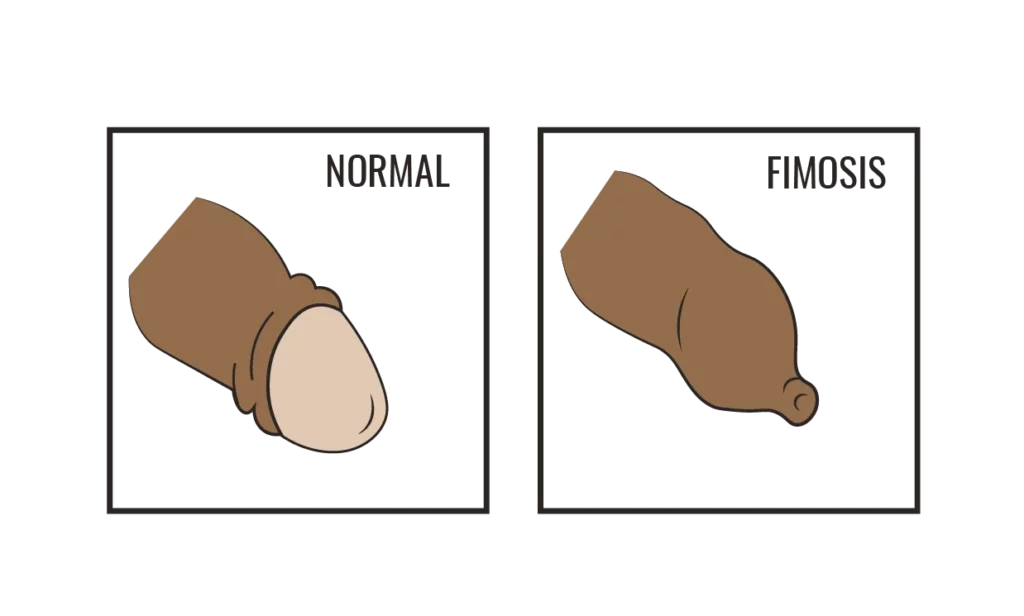Are you having difficulty retracting your foreskin? Does it become inflamed or cause any discomfort? Then, this article will help clarify some doubts about what may be happening to you. Phimosis is a constriction of the opening of the foreskin, the skin that covers the tip of the penis, preventing it from retracting properly. Among its most common symptoms are the difficulties or inability to fully retract the foreskin.
Among its consequences, there are discomfort when urinating or difficulty in proper hygiene of the area, as well as an increased risk of certain urinary tract infections. That’s why we wanted to dedicate an article to this problem with an easy solution. Stay until the end to find out the answers you’re looking for!
What is phimosis and what are its symptoms?
Phimosis is a condition in which the foreskin is narrow and cannot be fully retracted. The symptoms of phimosis can vary in intensity and may include:
- Pain or discomfort: In some cases, phimosis can cause pain or discomfort when attempting to retract the foreskin. This can occur during sexual activity, erections, or manipulation of the penis.
- Inflammation and irritation: Phimosis can lead to inflammation and irritation of the foreskin area due to the difficulty in properly cleaning underneath it. This can result in the accumulation of bacteria, secretions, and smegma (a whitish substance).
- Recurrent urinary tract infections: In some cases, phimosis can increase the risk of urinary tract infections due to the difficulty in maintaining good hygiene and eliminating bacteria.
This sex education should include education on the diversity of orientations, identities, bodies… However, this is not enough. “One does not necessarily connect with realities that are only present in textbooks. The media has a great deal of power in this regard,” Mario affirms.
Additionally, it should be emphasized that experiencing these symptoms does not necessarily mean you have phimosis, as other genital conditions such as contact dermatitis or some sexually transmitted infections (STIs) like chlamydia or gonorrhea can also be associated with these symptoms.

Consequences
Phimosis can have various consequences, especially if not treated properly. In addition to the symptoms mentioned earlier, there are some consequences associated with having phimosis that we also find important to mention:
- Balanitis: Phimosis increases the risk of developing balanitis, which is inflammation of the glans (the tip of the penis). The accumulation of bacteria and smegma beneath the foreskin can cause irritation and inflammation in the glans, which can be painful and cause discomfort during urination.
- Paraphimosis: Paraphimosis is a complication of phimosis in which the retracted foreskin cannot return to its original position. This can cause pain, inflammation, and constriction of the glans, which is a medical emergency that requires immediate attention.
- Sexual difficulties: In some cases, phimosis can hinder or prevent sexual intercourse due to discomfort, pain, or difficulty in retracting the foreskin.
However, it is important to note that not everyone with phimosis experiences all of these consequences, and the severity of symptoms and complications can vary from person to person. Therefore, we need to consider different types of phimosis.
Types and Grades of Phimosis
Yes, there are different types of phimosis. These can vary in severity and presentation, with the main types being the following:
- Physiological phimosis: This is the “natural” and common type of phimosis in infants and young children. In newborns, it is normal for the foreskin to be adhered to the glans and unable to retract completely. Over time, usually during the early years of life, physiological phimosis spontaneously resolves as the foreskin separates from the glans and becomes retractable. However, if it persists into adulthood, it can become chronic and cause problems.
- Cicatricial or acquired phimosis: This type of phimosis occurs due to scarring or narrowing of the foreskin as a result of injuries, infections, chronic irritations, or previous surgical procedures in the genital area. Cicatricial phimosis can be more difficult to treat than physiological phimosis, as the foreskin skin is often more rigid in these cases.
- Pathological phimosis: Pathological phimosis refers to a condition in which the foreskin is too narrow and cannot be fully retracted due to an abnormal structure or a congenital condition. It can be present from birth or develop later in life.
Well, with all this information, you can get an idea of whether it applies to your case or not. So, now you may be wondering…
What can I do?
If you have phimosis and are experiencing discomfort or difficulties related to it, it is recommended to seek medical attention for an accurate diagnosis and to determine the appropriate treatment. During the process, it is useful to consider the following points:
- Observation and personal care: If phimosis is not causing significant problems and is not causing discomfort, your doctor may recommend simply maintaining good genital hygiene and observing any changes or new symptoms. In some cases, phimosis can resolve naturally, although this is more common in teenagers.
- Topical treatment: In mild cases of phimosis, your doctor may recommend the use of topical steroid creams or ointments that are applied directly to the affected area. These creams can help soften and stretch the foreskin tissue, which can allow for easier retraction.
- Gradual dilation: This technique involves the use of special dilators or probes that are gradually inserted into the foreskin to stretch and widen it. This is done under the supervision of a doctor and may require several sessions.
- Circumcision: If conservative treatments are not effective or if phimosis is more severe, your doctor may recommend circumcision. Circumcision is a surgical procedure in which the foreskin is partially or completely removed. It is important to discuss the benefits, risks, and potential complications with your doctor before making a decision.

Conclusion
Now, you should have an idea of how important male intimate hygiene is in preventing discomfort and infections related to phimosis or other conditions of the foreskin. It is important to gently wash the penis and foreskin area with warm water and mild soap, although you can find more information on this topic in our article on the importance of male intimate hygiene.
And finally, remember that each case of phimosis is unique, so it is important to seek guidance from a doctor to determine the most appropriate treatment for you.

Author: Andrés Suro (Sexual Coach at MYHIXEL)
Psychologist specialized in the social area and expert in sexology applied to education.
Remember you can book a private consultation with me at MYHIXEL CLINIC. Book your appointment here.
Do you have any questions about our online consultation service? Contact us through our WhatsApp Business +34 643 84 91 23






